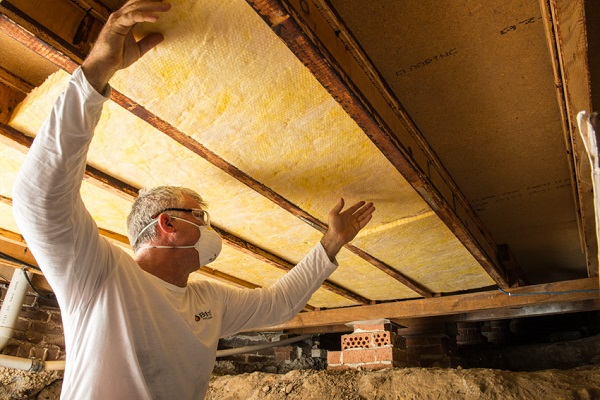Stepping up to the NCC 7-Star Rating: Australia’s construction industry redefines energy efficient homes

Australia’s construction industry is rapidly evolving towards sustainable energy-efficient homes, with notable changes in the National Construction Code (NCC) 2022 energy efficiency provisions for new homes to take effect (with various State transition periods) from October 1, 2023. The introduction of the NCC 7-Star rating will rely heavily upon the insulation sector, yet achieving this rating need not completely change the way we build.
Insulation for the roof, walls and floor, is a cornerstone of energy-efficient building design. Proper insulation not only reduces energy consumption for heating and cooling, but it also ensures a more comfortable and healthy living environment. It can also significantly contribute to noise reduction, leading to more peaceful and quiet interiors.
Given Australia’s diverse climatic zones, insulation has to work both ways – keeping homes cool in the scorching summer months and warm during the chilly winters. A well-insulated home reduces reliance on air conditioning and heating systems, cutting energy consumption and greenhouse gas emissions.
The new NCC 7-Star rating is a significant step forward in promoting more energy-efficient and durable systems with a longer-term net zero goal design and construction practices in Australia. This standard primarily affects the residential sector, pushing the building trade to adopt new approaches and techniques to achieve higher energy efficiency levels.
In addressing the forthcoming introduction of the NCC 7-Star rating, Bradford Insulation general manager of marketing and customer operations, Kathy Hocker, says: “We are at a pivotal point in the industry. The advent of this new rating is set to bring about a significant change in insulation installation and usage across Australian residences. We foresee a boost in demand for sophisticated insulation materials, to meet the increased energy efficiency standards. However, before we go through this transformation, there are a number of factors that builders, specifiers and architects should understand and which homeowners of new builds should also be across.”
Under the previous regulations, the minimum required rating was 6 stars. With the new NCC 7-Star rating, buildings will need to have even higher insulation, glazing, sealing, design or layout and passive solar design to meet the higher standards. This update represents a 18-25% improvement for homeowners on the base energy efficiency requirements as compared to the older NCC 6-Star rating.
As builders and architects will need to adapt and incorporate different design or layouts and material selections that help to comply with these standards, the following are practical tips and strategies designed to help industry professionals in effectively explaining these changes to their clients, enabling them to make well-informed decisions about their insulation choices.
- Don’t ignore R-values: An R-value is a measure of thermal resistance; a higher R-value is likely the most cost-effective choice for achieving energy efficiency in any design. Regardless of the climate zone, building orientation, or construction type, prioritising a higher R-value insulation should be a fundamental part of a building plan and recommendation to homeowners.
- Look for quality products: Quality is key in insulation products for their effectiveness and longevity. Bradford Gold and Bradford Gold High Performance Insulation is designed for Australia’s unique climate and has been independently tested for performance under various conditions. It’s also certified to Australian standards, meeting or exceeding compliance guidelines for thermal performance. Bradford products are also accredited for fire safety, environmental sustainability, and health considerations.
- Don’t overlook acoustic insulation: Alongside thermal insulation, consider the benefits of acoustic insulation to help reduce noise transmission between rooms and from external sources. Some insulation materials such as Bradford SoundScreen provide both thermal and acoustic benefits.
- Install properly: Even the best insulation won’t perform well if not installed correctly. It’s essential that insulation fits snugly between studs, joists, and beams, without gaps or compression so it retains its design thickness. Installation in accordance with the NCC and Australian Standards is always recommended.
- Seal it up: A well-insulated home isn’t just about the insulation itself; it’s also about preventing air leaks and minimising hot and cold draughts blowing through the home. Builders should ensure gaps around windows, doors, and other areas prone to air leaks are properly sealed.
- Don’t forget condensation control: While sealing a home for energy efficiency is important, so too is ensuring sufficient moisture control and ventilation to reduce the risk of condensation, mould growth, and poor air quality. Vapour permeable wall wrap and ventilation solutions should be considered as part of the overall design.
- Understand the full cost: The cost of insulation isn’t just about the price of the product. It also includes installation costs and the ongoing savings in energy costs that the insulation will provide over its lifetime. Optimising insulation is more cost-effective compared to enhancing other more expensive building components, as it provides an overall Star rating gain for less than the cost of other building elements.
As Australia continues to move towards a more sustainable future, it’s likely that energy efficiency standards will continue to rise. The new NCC 7-Star rating not only demonstrates a commitment to energy efficiency stewardship but also presents a wealth of opportunities for better practices in building design and construction. The insulation industry in Australia is stepping forward to a 7-Star rating and, with it, the future of sustainable living.
For more information about Bradford Insulation products visit this link.
